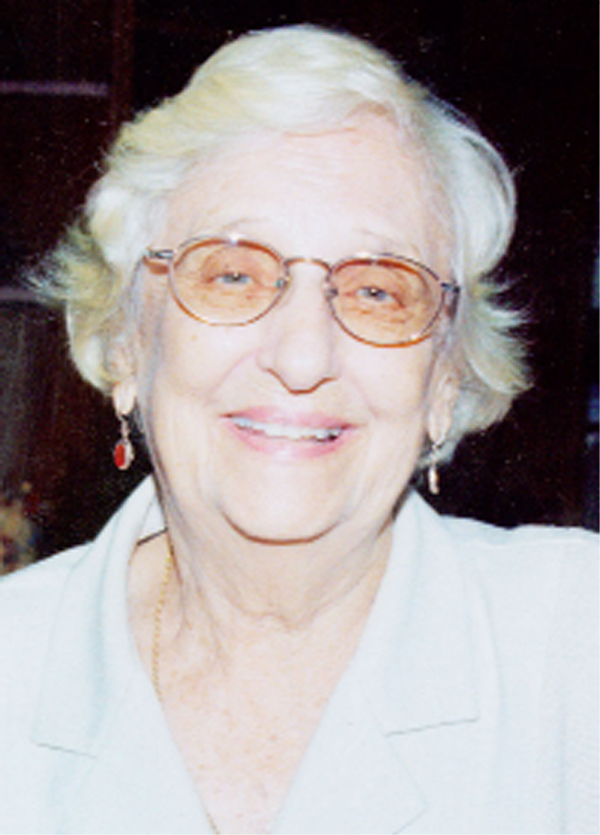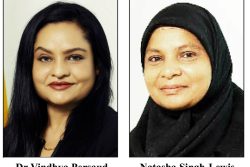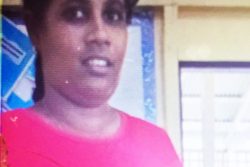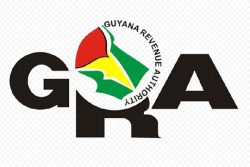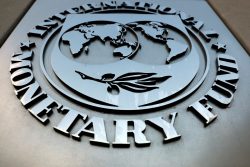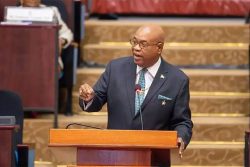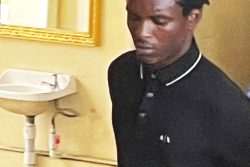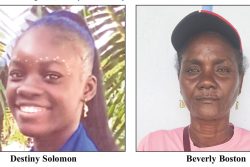Art requires talent – real talent and not mere literacy in any medium. I see no substitute for passion, internally generated, and hard work. -Martin Carter
Hark! The rolling of the thunder!
Lo! The sun, and lo! Thereunder,
Riseth wrath and hope and wonder
-William Morris
The words of these two poets, Martin Carter and William Morris, are directly related to the work of Janet Jagan. That is because she was clearly inspired by Morris, the nineteenth century poet and songwriter who was known as ‘The Poet Laureate of Socialism.’ His verses, which were often rallying chants for the communist cause, were used as the theme for the publication Thunder, which she edited. As a poet and an intellectual, Carter was equally fired up by the political movement of the early PPP and worked with her on the editorial board of the publication. He was thus inspired by that cause and thereafter was an inspiration to Mrs Jagan as one of her favourite poets. Indeed, her life’s work helped to nurture literary talent and she was certainly not lacking in the “passion” and “hard work” that Carter saw as prerequisites for creativity.
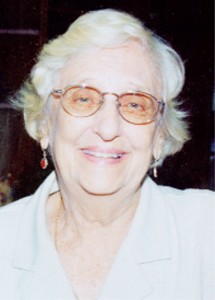 Without doubt, and recognised even by some of her most scrupulous critics, that internally generated passion and hard work became characteristic of the life’s work of Mrs Janet Jagan, OE, former President of Guyana, who was decorated by UNESCO with the Gandhi Gold Medal for her socio-cultural activities. Her contribution to Guyanese nation-building was immeasurable, involving an intense anti-colonial struggle on behalf of the labour movement, independence and the rights of women. She worked at the vanguard of a proletarian putsch in the interest of the working class, agricultural
Without doubt, and recognised even by some of her most scrupulous critics, that internally generated passion and hard work became characteristic of the life’s work of Mrs Janet Jagan, OE, former President of Guyana, who was decorated by UNESCO with the Gandhi Gold Medal for her socio-cultural activities. Her contribution to Guyanese nation-building was immeasurable, involving an intense anti-colonial struggle on behalf of the labour movement, independence and the rights of women. She worked at the vanguard of a proletarian putsch in the interest of the working class, agricultural
workers and the peasantry. Hers was a rare dedication of a life to an adopted country which ranged from struggle through controversy and contradictions to achievement.
A not insignificant part of the sum total of that contribution was in the fields of literature and the arts. Yet Mrs Jagan’s work in these areas was closely allied to her politics, her ideology, Marxian outlook which were consistent with her “working class orientation” and “enlightened humanism.” At launchings, readings and other like occasions, politicians are always being presented with a copy of the book, and it has always been said that of all the officials in the party, Mrs Jagan was the one who would read it. Biographical reports stress her early initiation into the arts, her extensive travels to visit museums as a teenager in America and her own declaration in an interview in 1993 that she tried to read at least one book each week.
Such reports are consistent with her activities during her career of 65 years in Guyana. It might have been a mixture of her firm belief in the cultural policy of the communist ideology, her concerned humanism and her personal love of literature, but from the establishment of the PAC and the PPP right up to the last five years of her life in the first decade of the 21st century, Janet Jagan was the one repeatedly called upon by her party to perform in literary, intellectual or artistic matters. She had a long career as editor, journalist, administrator, facilitator, critical writer and fiction writer.
She was the editor of the PAC Bulletin after Cheddi Jagan, Ashton Chase and herself formed the Political Affairs Committee. When this body was transformed into the People’s Progressive Party she became the editor of Thunder, the party organ in 1950, and much later when the Mirror came into being in 1962 Janet Jagan edited it. She served consistently in other roles as well, as contributor, columnist and in the public agitation launched through those pages, particularly between 1954 and 1955, including a particularly active period following her release from detention. While she organised the Union of Guyanese Journalists for political motives, to counter the Guyana Press Association which had at the time been appropriated by the ruling PNC, it was a vehicle through which she organised seminars and discussions which included literary and cultural topics in the 1980s.
Thunder
Mrs Jagan’s involvement with Thunder transcended her work as a journalist. An editorial board was set up and between 1950 and 1955; it included Janet and Cheddi Jagan, LFS Burnham, Martin Carter and Lionel Jeffrey. After October 1968 when it was last published as the monthly official organ of the party, Thunder changed its existence. From the July-September 1969 Issue it became a “Quarterly Theoretical and Discussion Journal of the PPP.” Mrs Jagan served as editor at different times; other editors intervened, such as BH Benn in 1957 and Dr Charles Jacob Jnr in 1968, but she was always involved as contributor. On some occasions during those other editorships, she even wrote the editorial. But even as late as 2005 she was asked to edit the journal again, producing many quarterly editions right up to the latest issue in March 2009.
For a party organ the range, scope, interests and intellectualism of Thunder exceeded a partisan agenda to include national and socialist causes and the arts. It engaged the rallying lines of a poet as its slogan. ‘Hark! The rolling of the thunder!’ is taken from the poem ‘Chant for Socialists’ in William Morris’s The March of the Workers written in the late 19th century to support socialism. Jagan’s numerous contributions include weighty political articles such as ‘The Long Battle to Defeat Compulsory Arbitration’ in 1971 as well as others in defence of literature such as ‘On the Banning of Books’ in 1954. The editions covering more than 30 years are rich in nationalism and culture.
A random sample of titles reflect these broad interests. Some of them are comments on the ‘Luckhoo Subversive Literature Bill’; ‘Who controls the Press?’; a ‘List of Banned Books’ in 1955; several book reviews; quotations from poets and film reviews. A glance at the last mentioned provides a good indication of how deep and informed this cultural content has been. Films reviewed included East of Eden from the novel by American Nobel Laureate John Steinbeck and directed by Oscar Winner, Elia Kazan who is numbered among the most accomplished screen and stage directors by academia and scholars of film.
Martin Carter
This keen interest in arts and culture is also consistent with the fact that one member of the editorial board of Thunder was a young man who grew to be Guyana’s greatest poet. Martin Carter worked very closely with Mrs Jagan throughout the fifties and Thunder provided an outlet for his prose writings, undoubtedly contributing to his intellectual development. He was a regular contributor and produced a substantial collection of prose pieces in the party’s theoretical organ. These ranged from the philosophical and political such as ‘The Power to Change’ and ‘Freedom from Imperialism – Freedom to evolve’ to the half-humorous metaphorical ‘Wanted: A Great Obeahman,’ critical analysis and the poetic. Like Jagan, Carter helped to keep literature a regular feature among the published contents. He wrote on Chilean poet Pablo Neruda, describing him as “one of the greatest living poets in the world” in his introduction to Neruda’s poem ‘I Want the Earth’ which was printed in the January 15, 1955 issue of the then weekly publication. The interest in Neruda was sustained until much later when his speech in Helsinki in 1965 was reproduced in the journal.
Oral history or legend has it that so close was Carter to Thunder in the decade of the fifties that even after he withdrew from active politics in the PPP, when he was employed by Bookers and could no longer write for it, he still contributed to it without using his name. For quite a while Thunder carried a campaign against Bookers for its alliance with British imperialism, urging readers to “drink less rum”!
The Mirror
The Mirror was launched as a daily and Sunday newspaper on December 16, 1962 and provided another editorial assignment for Jagan. Again, she turned it into more than standard journalism. It was another arm of the struggle and demonstrated her perseverance against a hostile and prohibitive political environment. The Mirror withstood concerted strategies by the PNC government to close it down for several years, but suspended its operations on June 15, 1972 under the pressure of a continued ban on the importation of newsprint which was later to suppress the Catholic Standard and Dayclean as well while the government kept a tight lid on dissent.
Jagan turned the Mirror into another opportunity for a sustained focus on the arts. She contributed to it at various times as editor, but always as journalist and right up to her death in March 2009 as columnist. The newspaper, which eventually became a weekly, published a column on the arts, much reduced in recent years, with consistent reviews of books and art. Jagan used these reviews at one time to provide an outlet for struggling writers to earn a small income.
One of the most important serials published by her in the Mirror was the autobiography of Helen Taitt, Guyana’s greatest classical dancer. Taitt had returned home to Guyana after living in Germany for several years and after an extended sojourn as a professional dancer overseas. As editor at the time, Jagan agreed to provide an outlet for Taitt’s series about her experiences, and the arts of Guyana was the main beneficiary. She was also instrumental in assisting the dancer-choreographer’s resettlement and the setting up of her dance school in Georgetown.
Freedom House
Even outside of publications, Mrs Jagan remained faithful to Marxist philosophy, for which both herself and Cheddi came in for much criticism. But Marx emphasized the importance of culture and Mrs Jagan’s promotion of it in the Guyanese society could only have been to the national good. This criticism was also aimed at the Jagans’ attention to the rural Indian peasantry whence came most of their political support, but Janet’s cultural activism targeted the urban population.
She worked with Gail Teixiera to organise several public cultural programmes out of Freedom House in the 1980s while in opposition and suffering a harassing wilderness experience. These programmes, held on Robb Street, in the National Museum and other venues, included fine art exhibitions, discussion panels on culture, films and photography. Again, the way these were conducted is testimony to the depth, quality and knowledge of the arts that informed them.
The art exhibitions were able to show some of the best of contemporary Guyanese painting. The films chosen included some of the most enlightening and acclaimed, such as Peter Shaffer’s Amadeus, the celebrated movie by Milos Forman on the life of Mozart, cleverly narrated in the film by the Official Court Composer Antonio Salieri, an embittered rival of Mozart but sufficiently saddened by his realisation that he was a lesser talent to be a reliable narrator. The public discussions included a panel on reggae, Bob Marley and the popular culture. Photography included a photo competition in which a number of the leading newspaper photographers like Ken Moore, who was one of the prize winners, competed. Freedom House also published a book of Hawley Harris cartoons in the 1970s.
Stories for children
When faced with this range of activities, most of which are substantial, it is difficult to rate them in any hierarchal order, but among the most important works of Janet Jagan in literature are her ventures into creative writing. In paying her tribute, her daughter Nadira said that when she was a child, in preference to play or toys, her mother would always read to her or give her books, encouraging her to read. And indeed, Mrs Jagan has explained that she decided to try writing stories when she wanted to expose her grandchildren to Guyanese stories and found that there were hardly any written for children. She did not like to feed them a diet of foreign tales, so she started writing about the Guyanese animals that they would have seen in the zoo, about Guyanese events and adventures set in Guyana. She eventually wrote and published several of these.
The children’s literature that she produced was perhaps meant to educate first and amuse in the process, since she also attempted narratives of historical events. One of her earliest publications of this type was Children’s Stories of Guyana’s Freedom Struggles (1995) published by the New Guyana Company with illustrations by Paul Harris. It invited controversy because of an interpretation of this history that did not manage to escape her own deep involvement in or closeness to some of the events and ended up too near to politics. She was accused of focusing on Cheddi Jagan and PPP contributions to the struggles at the expense of others, and of ethnic bias in some of the illustrations.
Above that, Jagan was very prolific in her contribution to Guyanese children’s literature and produced a number of worthy collections, most of them animal fables highlighting the interesting population of creatures in Guyana’s interior. They include quite a few delightful tales with good techniques of narration using plot and characters predominantly to promote wholesome values and a love of animals.
The title of the first collection tells the story of Jagan’s original reason for writing fiction – to entertain her grandchildren. When Grandpa Cheddi was a Boy (1993), Peepal Tree Press, was the first of many published in the UK. It was followed by Patricia the Baby Manatee and Other Stories (Peepal Tree, 1995), Anastasia the Anteater and Other Stories (Peepal Tree, 1997) and The Dog Who Loved Flowers (Peepal Tree, 2000). These neat, colourful volumes, richly illustrated in most cases by Hawley Harris, but also by Paul Harris and others, have far transcended a grandmother’s original motivation and serve a wide national audience. Another collection was published in Canada by Harpy, Ontario, 2001: The Alligator Ferry Service and Other Stories from Guyana with illustrations by Elizabeth Burke.
Publications
There are several other Jagan publications, some of which may be more highly regarded because of the importance of their contribution to local literature. These include another book in her favourite area of fiction for children, and it is greater in magnitude because of the achievement of the purpose as stated in her critical introduction. It collects in one rare volume, stories from Guyana by different authors. The Lure of the Mermaid and Other Children’s Stories from Guyana is edited by Janet Jagan and published by Dido Press in the UK in 2004. It reprints stories by an interesting range of writers such as Jan Carew, Walter Rodney, Rajkumarie Singh, Krishna Nand Prasad and a number of others. Jagan’s introduction to this book may be compared, for the quality of its critical contribution, to the introduction she wrote to another of her most important publications outside of children’s fiction.
This is My Life, My Country by Helen Taitt (2006) published by the New Guyana Company and introduced by Mrs Jagan, who was responsible for bringing this very valuable autobiography into existence. It puts together in book form, the serialised chapters submitted to the Mirror and printed between 1992 and 1993. It is the only record of the life and work of Taitt who was Guyana’s most remarkable professional ballet dancer, choreographer and dance teacher. Jagan cared enough that this work should be known to print and promote it.
Also to be counted among her more significant literary pieces is her interview with the great American singer and actor Paul Robeson conducted in New York and published in Thunder in March 1957. In addition to that, she also contributed a Foreword to Cheddi Jagan: Selected Correspondences 1953 – 1965, edited by David Dabydeen and published by Dido in 2004.
Yet other introductions were written for The Journal of the Cheddi Jagan Research Centre, Vol.1, April 2008; A New Global Human Order, which was her husband’s work reprinted by their daughter Nadira Brancier at Harpy publications in Ontario, 1999; Insightful Views on Guyana by Hydar Ally, 2008; Remembering Minister Sash Sawh, 2006 to which she contributed; and Iraq Exposed: Articles from Mirror Newspapers 2002–2004 by Janet Jagan and Donald Ramotar.
Castellani House
However, any attempt to assess the contribution of Janet Jagan to the cultural life of a Guynanese nation must begin with Castellani House. She has been the most influential figure in that prominent and important institution from its conception in 1993. She was board Chairman from its establishment and served in that capacity for the rest of her life. The first function of Castellani House was to provide a home for the national art collection and a location for the National Gallery. It was the satisfaction of an urgent need in the interest of national cultural heritage in which she was central. Although managed by Curator Elfrieda Bissember, the board, with Mrs Jagan in the chair, has also been involved in the institution’s many creative ideas.
Castellani House has hosted or has been responsible for most of the nation’s most important art exhibitions, awards and competitions. It has been a school of art for students, researchers and the general audience for art through its contemporary, historic and retrospective shows. Funded by the Office of the President, it gradually became a virtual cultural centre and one of the most active venues for cultural and artistic events. The ‘House’ has made an excellent contribution to literature and film in particular with numerous launchings of new books, poetry and prose readings, discussions, panels, lectures and a regular programme which introduces and shows films and selections from the archives of the cinema.
Castellani House has therefore been one of her two most telling contributions as a member of government. The other is the return of a more vibrant Ministry of Culture. On becoming President in 1997, Mrs Jagan removed the Ministry of Culture from Education and re-assigned Gail Teixiera in her cabinet to head the new Ministry of Culture, Youth and Sport. The choice of Minister might well have been influenced by the fact that it was Ms Teixiera who had been her comrade in the arts during those several cultural activities while they were in Opposition. And sure enough, the government’s cultural agenda was re-energised. The Minister of Culture, Youth and Sport set about the revival of Mashramani, a national festival that had been floundering as a victim of political attitudes from both sides. It was rescued by a new positive energy and it was also possible to foreground a number of other cultural programmes. The impact and lasting heritage from Carifesta, for example, will be felt in Guyana for a long time.
All these several events, developments and influences have in many ways, directly and incidentally, been affected by the work of a former President, a former political activist for whom attention to culture was an ideological necessity. But even more than that, while she spent in excess of 50 years as one of the most influential political personalities in Guyana, an invaluable accumulation of national gains may be regarded as spinoffs from Mrs Jagan’s personal, consistent and evergreen interest in the arts.
